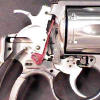That is NOT a hammer block. It's a transfer bar.
Look at the pic again: with the trigger pulled, that piece of metal the red arrow is pointing to will come UP and sit on top of the firing pin. The hammer can then hit it. Look at the face of the hammer in this pic: there is a "step" that hits the frame above the firing pin. When the transfer bar is retracted (no pressure on trigger) that "step" will block the rest of the hammer below that step from hitting the firing pin. When cocked the trigger will be rearwards and the firing pin up and ready to make bang, but as the hammer falls the trigger will go forward and retract the transfer bar. If you pull the trigger to fire, the transfer bar will rise a little bit more from where it's at in this pic.
This "tip" will help you understand the gun better:
Let's say you were deep in the woods and you broke the transfer bar off. Your gun is now a doorstop. Say you manage to shake loose the broken end of the transfer bar. Your only tool is a file. You can shave off that "step" and render the hammer face completely flat, which in turn would make the gun safe for five-up carry only. Which would at least get you a gun fit for a wilderness survival situation until you can score a new hammer off Brownell's

.
----
On a hammer-block gun, the hammer block moves DOWN when the trigger is pulled, not up. In it's upward position it prevents a full forward movement of the hammer. A transfer bar doesn't impede the hammer at all, it simply renders the hammer useless as far as hitting the firing pin is concerned. Only the combined hammer and transfer bar *jointly* can hit the firing pin.
----
There are a couple of transfer bar designs where the transfer bar is built into the front face of the hammer itself, and is hard to see until you look at the hammer face. Rugers don't use this, only the Beretta Stampede and Freedom Arms '97 frames that I know of do this. It still works the same way as other transfer bars, same level of safety.
With the Ruger-type transfer bar, something has to push the transfer bar rearwards as it moves up, otherwise it could slam into the firing pin's side and tie the gun up. On a Ruger single action revolver, the "base pin" (the "axle" that the cylinder rotates on) has a spring-loaded tip as it goes into the back of the frame. That's what pushes the transfer bar backwards. If you remove the cylinder and base pin from a Ruger SA, the action will still work as long as the barrel is tilted upwards, letting gravity drag the transfer bar back. If you try it horizontal or muzzle-down, whoops. Every once in a while (VERY rare!) the spring-loaded tip can get clogged up. If you ever have a Ruger "tie up on you" on cocking, back off, point it to the sky and try again. The cure is a new base pin as the small "poker" and small spring are "tacked" into the end of the base pin.
Whenever you have the cylinder out of the Ruger, check the end of the pin for "springiness" or any sign of it being sticky. Buy a Belt Mountain base pin if it's at all a concern. Again: your odds of running into this are ridiculously low.
This failure mode is impossible with the transfer bars integrated in the hammer face.



